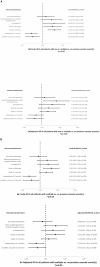Baseline characteristics and outcome of stroke patients after endovascular therapy according to previous symptomatic vascular disease and sex
- PMID: 38694775
- PMCID: PMC11061446
- DOI: 10.3389/fneur.2024.1293905
Baseline characteristics and outcome of stroke patients after endovascular therapy according to previous symptomatic vascular disease and sex
Abstract
Aim: The aim of this study was to investigate baseline characteristics and outcome of patients after endovascular therapy (EVT) for acute large vessel occlusion (LVO) in relation to their history of symptomatic vascular disease and sex.
Methods: Consecutive EVT-eligible patients with LVO in the anterior circulation admitted to our stroke center between 04/2015 and 04/2020 were included in this observational cohort study. All patients were treated according to a standardized acute ischaemic stroke (AIS) protocol. Baseline characteristics and successful reperfusion, recurrent/progressive in-hospital ischaemic stroke, symptomatic in-hospital intracranial hemorrhage, death at discharge and at 3 months, and functional outcome at 3 months were analyzed according to previous symptomatic vascular disease and sex.
Results: 995 patients with LVO in the anterior circulation (49.4% women, median age 76 years, median admission NIHSS score 14) were included. Patients with multiple vs. no previous vascular events showed higher mortality at discharge (20% vs. 9.3%, age/sex - adjustedOR = 1.43, p = 0.030) and less independency at 3 months (28.8% vs. 48.8%, age/sex - adjustedOR = 0.72, p = 0.020). All patients and men alone with one or multiple vs. patients and men with no previous vascular events showed more recurrent/progressive in-hospital ischaemic strokes (19.9% vs. 6.4% in all patients, age/sex - adjustedOR = 1.76, p = 0.028) (16.7% vs. 5.8% in men, age-adjustedOR = 2.20, p = 0.035). Men vs. women showed more in-hospital symptomatic intracranial hemorrhage among patients with one or multiple vs. no previous vascular events (23.7% vs. 6.6% in men and 15.4% vs. 5.5% in women, OR = 2.32, p = 0.035/age - adjustedOR = 2.36, p = 0.035).
Conclusions: Previous vascular events increased the risk of in-hospital complications and poorer outcome in the analyzed patients with EVT-eligible LVO-AIS. Our findings may support risk assessment in these stroke patients and could contribute to the design of future studies.
Keywords: acute stroke therapy; atherosclerosis; cerebrovascular disease/stroke; endovascular treatment; large vessel occlusion.
Copyright © 2024 Peycheva, Padlina, Genceviciute, Krasteva, Boronylo, Goeldlin, Müller, Wenz, Müller, Hammer, Bücke, Bigi, Simonetti, Hoffmann, Umarova, Pilgram-Pastor, Gralla, Mordasini, Antonenko and Heldner.
Conflict of interest statement
The authors declare that the research was conducted in the absence of any commercial or financial relationships that could be construed as a potential conflict of interest. The author(s) declared that they were an editorial board member of Frontiers, at the time of submission. This had no impact on the peer review process and the final decision.
Figures




References
-
- Virani SS, Alonso A, Aparicio HJ, Benjamin EJ, Bittencourt MS, Callaway CW, et al. . American Heart Association council on epidemiology and prevention statistics committee and stroke statistics subcommittee. Heart disease and stroke statistics-2021 update: a report from the American heart association. Circulation. (2021) 143:e254–743. 10.1161/CIR.0000000000000950 - DOI - PubMed
-
- Aboyans V, Ricco JB, Bartelink MEL, Björck M, Brodmann M, Cohnert T, et al. . ESC Scientific Document Group. 2017 ESC guidelines on the diagnosis and treatment of peripheral arterial diseases, in collaboration with the European society for vascular surgery (ESVS): Document covering atherosclerotic disease of extracranial carotid and vertebral, mesenteric, renal, upper and lower extremity arteries. Endorsed by: the European Stroke Organization (ESO) the task force for the diagnosis and treatment of peripheral arterial diseases of the European society of cardiology (ESC) and of the European society for vascular surgery (ESVS). Eur Heart J. (2018) 39:763–816. 10.1093/eurheartj/ehx095 - DOI - PubMed

